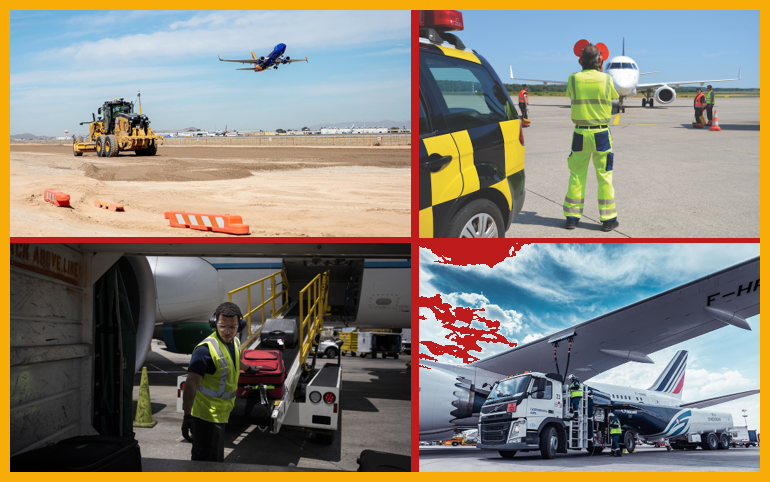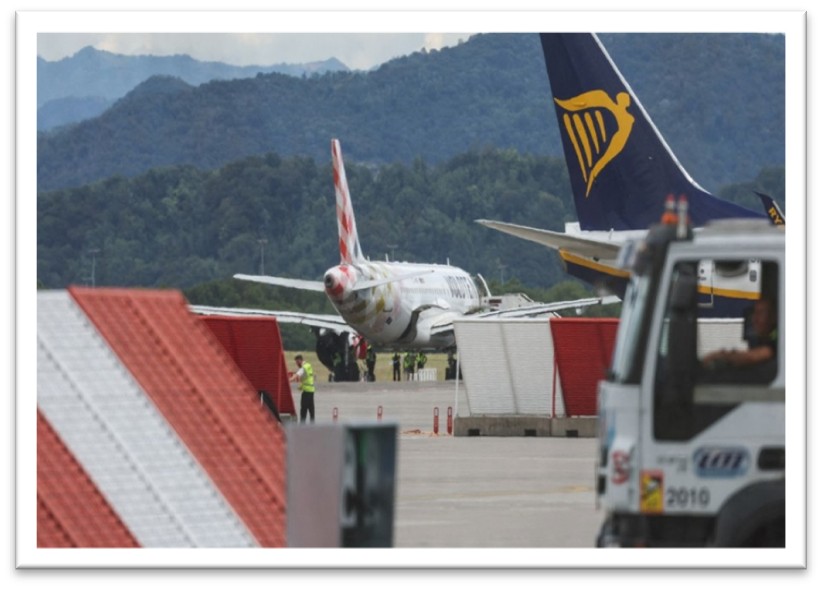SMS analysis at AIRPORTS requires an array of parties to see all risks

Safety Management Systems (SMS) are NOT INTENDED TO TAKE “SILO” VIEWS OF AVIATION RISKS. Even when the organization installing this safety regime assesses its environment, the vision for this task MUST BE AS BROAD AS POSSIBLE. EXOGENOUS FACTORS CAN BE AS DAMAGING ENDOGENOUS FACTORS.
Recently two highlighted events—catering truck hitting an aircraft and an individual being ingested in an airplane’s engine (see two stories below)-show the needed breadth of assessment for aviation ecosystems in the SMS process. This list of a number of such accidents/incidents demonstrates that problems may overlap- air carriers, airports, vendors and more:
- Montgomery Regional Airport, Alabama (Dec 31, 2022)
A Piedmont Airlines ramp agent, Courtney Edwards, was killed after being pulled into the engine of an Embraer E175 operating as American Eagle Flight 3408.- The aircraft’s APU was inoperative, so both engines remained running during cooldown.
- Despite two safety briefings, Edwards approached the aircraft to place cones before shutdown.
- The rotating beacon light was still on, indicating active engines.
- San Antonio International Airport, Texas (Jun 23, 2023)
A ground crew member working for Delta Air Lines was fatally ingested into the engine of an Airbus A319.- The aircraft had just arrived and was taxiing to the gate.
- The incident occurred during nighttime operations.
- FAA and NTSB launched investigations; Delta issued a statement expressing condolences.
- Amsterdam Schiphol Airport, Netherlands (May 29, 2024)
A KLM ground crew worker was killed after being sucked into the engine of an Embraer E190.- The aircraft was preparing for departure.
- Dutch authorities confirmed the engine was still running during pushback.
- The incident prompted a review of ramp safety protocols across European airports.Atlanta Hartsfield-Jackson (Sept 10, 2024)
A Delta Air Lines jet clipped the tail of an Endeavor Air plane while taxiing for takeoff. The smaller aircraft’s tail was torn off, but no injuries were reported.
- Doha Hamad International (Oct 25, 2024)
A Qatar Airways Boeing 787’s right main landing gear sank into a drainage hole while approaching the gate, causing the aircraft to rest on its right engine. No injuries, but significant damage occurred. - Seattle-Tacoma (May 17, 2024)
Two Alaska Airlines planes clipped wings while maneuvering in the gate area. Passengers deplaned safely. FAA noted that gate area movements are not under air traffic control. - London Heathrow (Apr 6, 2024)
A Virgin Atlantic Boeing 787 struck the stabilizer of a parked British Airways Airbus A350 during pushback. Minor damage, no injuries. - LaGuardia Airport (Mar 16, 2024)
Endeavor Air Flight 4814’s wing struck the runway during a go-around due to an unstable approach. FAA launched an investigation. - San Francisco International (Jul 12, 2024)
American Airlines Flight 2045 reported smoke at the gate. Passengers evacuated via emergency slides. FAA is investigating. - Charlotte Douglas International (Jan 27 & Jan 29, 2025)
A tragic accident occurred when an American Airlines ramp worker was fatally struck by a ground vehicle on the tarmac. - Charleston International (Jul 18, 2025)
An ANA Boeing 787 struck the tail of a parked Breeze Airways Airbus A220 during taxiing. Two passengers sustained minor injuries. FAA investigation is ongoing. - Newark Liberty International (Jul 14–15, 2025)
Severe storms led to massive delays. Some flights were stuck on the tarmac for over five hours waiting for gate access. While not a collision, it raised concerns about tarmac delay protocols. - Montgomery Regional Airport, Alabama (Dec 31, 2022)
A Piedmont Airlines ramp agent, Courtney Edwards, was killed after being pulled into the engine of an Embraer E175 operating as American Eagle Flight 3408.- The aircraft’s APU was inoperative, so both engines remained running during cooldown.
- Despite two safety briefings, Edwards approached the aircraft to place cones before shutdown.
- The rotating beacon light was still on, indicating active engines.
- San Antonio International Airport, Texas (Jun 23, 2023)
A ground crew member working for Delta Air Lines was fatally ingested into the engine of an Airbus A319.- The aircraft had just arrived and was taxiing to the gate.
- The incident occurred during nighttime operations.
- FAA and NTSB launched investigations; Delta issued a statement expressing condolences.
- Amsterdam Schiphol Airport, Netherlands (May 29, 2024)
A KLM ground crew worker was killed after being sucked into the engine of an Embraer E190.- The aircraft was preparing for departure.
- Dutch authorities confirmed the engine was still running during pushback.
- The incident prompted a review of ramp safety protocols across European airports.
Statistically this number of events may not flag these intersections for immediate review, but the potential harm that these risks may incur merits not only a thorough review but should involve a conjoint effort by all of those involved at airports—
- AIRLINES (flight and cabin crew, ground handlers, passenger service agents, security personnel, managers who are responsible for on airport vendors, safety professionals),
- AIRPORT (operations team, safety professionals, contract administrators [especially those who qualify vendors to have airport access], staff who are responsible for road, taxiway and tarmac traffic, security [especially those knowledgeable about the perimeter, police/security…
- FAA controllers not only control ground movements, but have exceptional views of where the points likely to pse problems.
Last but not least
- VENDORS their staff have been involve in almost all of these reported events. Contracted companies that handle bags, deliver food, refuel planes, clean aircraft interiors, aircraft maintenance and organizations that build/maintain the airport’s infrastructure (runway and taxiway; wildlife; snow; navaids; fences) are not directly under the SMS umbrella. Perhaps before including in the full array of airport participants, it would be useful to give them a course on SMS; otherwise, their input would not be as helpful.
Such a diverse group is absolutely essential to examine the range of potential problems, but it is highly unlikely that the assemblage has had many opportunities to work through the SMS procedures. Not every participant will have the perceived stature/size/voice to be comfortable contributing, especially if anyone of the heavy hitters chairs the SMS sessions.
An outside facilitator, knowledgeable in the application of SMS to all aspects of airports, should help encourage all points of view to be heard.
Man dies at Milan airport after being sucked into jet engine, local media reports
Aircraft can be seen on the runway at Milan Bergamo Airport, northern Italy, where a man died after being sucked into the engine of a departing plane, on July 8.
Claudia Gr eco/Reuters
Rome CNN —
A man died after he was sucked into the engine of a departing plane at Milan airport in northern Italy, local media reported on Tuesday.
The aircraft had just left the stand at Milan Bergamo Airport en route to Asturias, northwestern Spain, on Tuesday morning local time, according to CNN affiliate Sky TG24, when the incident occurred.
Corriere della Sera newspaper reported that unnamed airport officials said an individual ran onto the tarmac as the plane was preparing to take off and got sucked into the engine.
An individual who was not onboard the plane or affiliated with the airline was “seriously injured,” according to the Spanish carrier Volotea. All 154 passengers and six crew members were safe and being provided with psychological support, Volotea said.
Authorities have launched an investigation into how the individual was able to reach the runway from outside the airport. CNN has contacted Milan airport officials and police for comment.
Officials resumed flights from the transit hub on Tuesday midday local time, according to the airport, after they temporarily delayed flights due to the incident.
CNN’s Antonia Mortensen reported from Rome. CNN’s Sana Noor Haq reported and wrote from London. Juan Pablo O’Connell contributed reporting.
American Eagle Embraer E175 Grounded After Catering Vehicle Crash In Boston
The driver of a Sky Chef catering vehicle reportedly suffered minor injuries after colliding with an American Eagle Embraer E175 jet on the ramp at Boston Logan International Airport (BOS). The aircraft, operated by Republic Airways, had no one onboard at the time of the accident, according to Boston 25 News.
The aircraft had arrived at Boston from New York JFK Airport the night before, close to midnight, as Flightradar24 data shows. Following the incident, it was towed to a hangar for inspection, and no further updates on its condition have been released.
The Embraer E175LR is a regional jet commonly used by American Eagle for short to mid-range flights. It typically features a seating configuration of 76 seats, including 12 First Class, 20 Premium Economy, and 44 Economy seats.
This incident adds to a series of recent ground-related occurrences involving Republic Airways-operated Embraer E175 aircraft. In April 2025, two American Airlines planes, including an Embraer E175 operated by Republic Airways, clipped wings at Ronald Reagan Washington National Airport.
The National Transportation Safety Board (NTSB) has been notified of the Boston incident and is expected to conduct a thorough investigation to determine the cause and recommend safety measures to prevent similar occurrences in the future.
:




